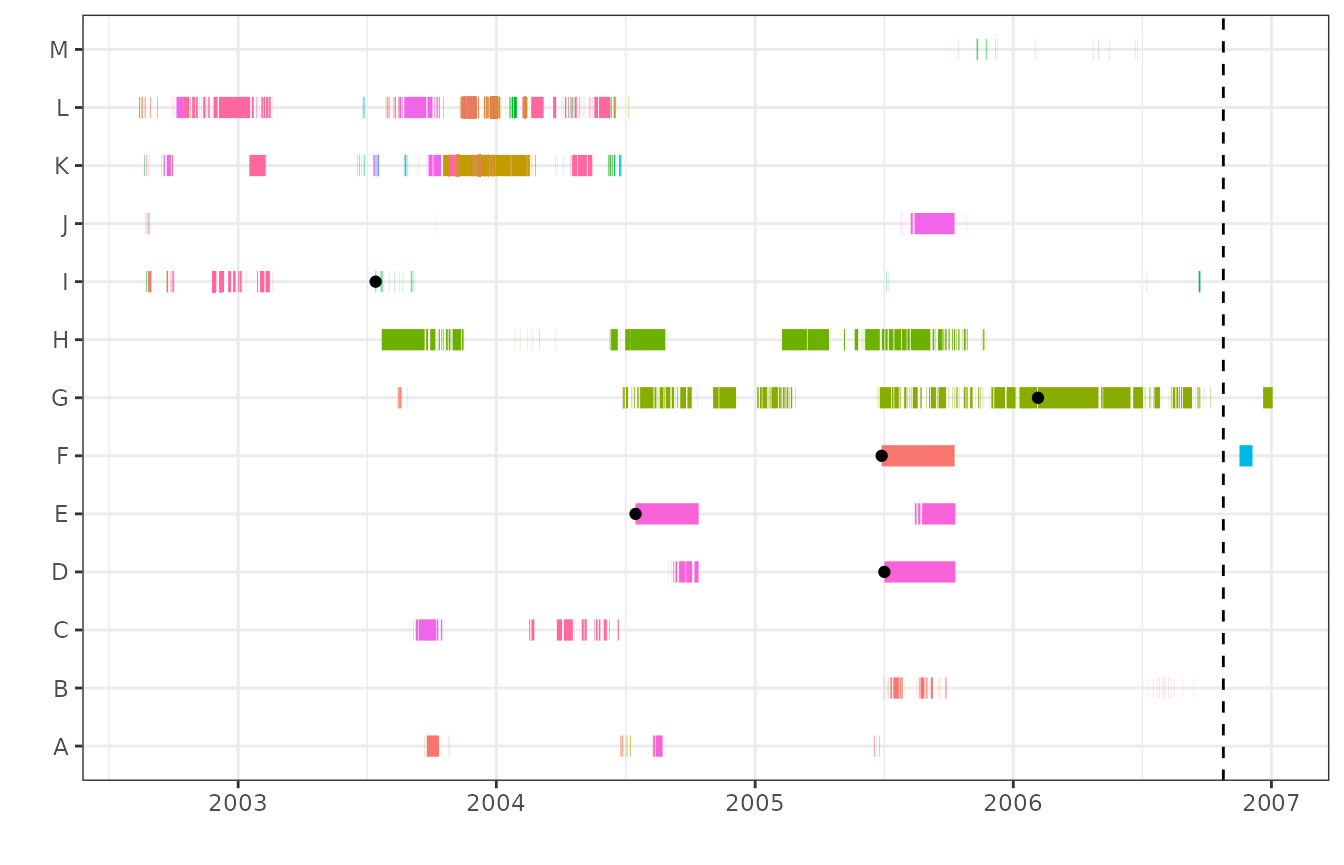morts is a conservative framework to flag potential mortalities. This means that it can overestimate potential mortalities and some flagged mortalities may actually be alive. If new data are available - such as from receivers that were not previously available or an additional year in multiyear studies - movement of incorrectly flagged mortalities may be apparent.
In the example below, the data used to flag potential mortalities is to the left of the dashed line, and the new data are to the right of the dashed line. There is no station change evident for Fish G in the new data, so this fish is still considered a mortality. There is, however, a station change for Fish F, indicating this fish is still alive.

The review() function examines new data to determine if
any animals move that were previously flagged as potential
mortalities.
Using review()
Two input dataframes are mandatory for review():
new.data- a dataframe with residence events generated from the new datasetmorts- a dataframe of previously flagged mortalities
The new residence events in new.data must be generated
using the same method as the original dataset, or must be manipulated to
match the format of the original dataset. The format of
new.data must also match the format of
morts.
The other four required arguments, type,
ID, station, and res.start, are
specified in the same way as for morts() and
infrequent(). See the Identifying
potential mortalities vignette for more information about these
arguments.
review_example<-review(morts=morts,new.data=new.data,type="mort",
ID="ID",station="Station.Name")If there are no station changes between the flagged mortalities and
new.data, or among the residence events within
new.data, then nothing is returned. If a station change is
found, the residence event with the station change will be returned.
Using the example in the first figure, Fish G is not included in the
output of review(), because it did not move since it was
flagged as a mortality. Fish F is included in the output, because a
station change was detected.
| ResidenceStart | Station.Name | ID | ResidenceEnd | ResidenceLength.days |
|---|---|---|---|---|
| 2006-11-16 19:31:00 | 27 | F | 2006-12-05 00:31:00 | 18.20833 |
The user can then review the station change to ensure it is valid
before removing the animal from morts and including the
animal in further analyses.
Including previous data
An optional input is old.data, which is the original
dataset or a subset of the original dataset that includes any residence
events that may have occurred between the flagged potential mortality
and the beginning of new.data. It is strongly recommended
to include old.data if backwards=TRUE when the
mortalities were previously identified and/or if drift was applied (see
Drift
vignette for more information on applying drift).
review_example<-review(morts=morts,new.data=new.data,old.data=events,
type="mort",ID="ID",station="Station.Name")Applying drift
There is the option to apply drift when using review().
If applying drift, the arguments ddd,
from.station, and to.station must be provided.
See Drift
vignette for more information on these arguments. In addition, the
arguments res.end, residences, and
units must be provided. These arguments are not necessary
for identifying station changes with no drift, but are called by the
function when drift is applied.
drift_review<-review(morts=morts,new.data=new.data,old.data=old.data,
type="morts",ID="ID",station="Station.Name",
res.end="auto",residences="auto",units="auto",
ddd=ddd,from.station="From",to.station="To")